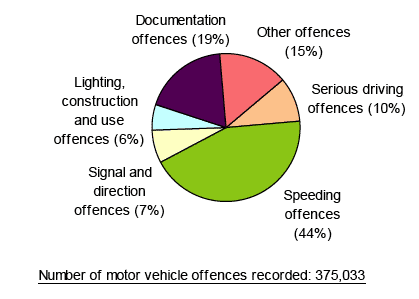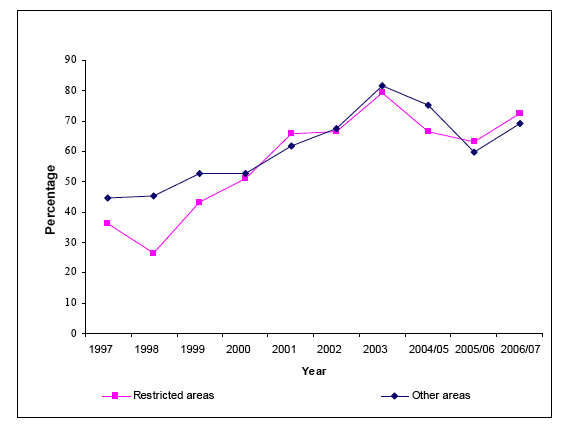Statistical Bulletin Crime and Justice Series: Criminal Proceedings in Scottish Courts, 2006/07
Criminal Proceedings in Scottish Courts 2006-07
10.1 Commentary: Motor Vehicle Offences: Context ( Table 20)
10.1.1 Most motor vehicle offences are dealt with by means other than court proceedings. Table 20 shows the numbers of offences which were dealt with by various means for the period 1997/98 to 2006/07. Further information on offences recorded, alternatives to prosecution and offences proceeded against in court is given in sections 10.2 to 10.7. Stationary vehicle offences, mainly parking offences, for which police fixed penalty notices are issued, are not included in the figures for recorded offences. However, moving offences such as speeding offences which are dealt with via the police and procurator fiscal conditional offer system are included. Further details of fixed penalty notices issued for stationary vehicle offences are given in section 10.5.
10.1.2 Non-payment of a procurator fiscal or police conditional offer of a fixed penalty is usually followed by prosecution. Consequently there is an overlap between conditional offers made and offences proceeded against in court.
10.1.3 The number of licensed motor vehicles in Scotland increased by over a quarter (28 per cent) between 1997/98 and 2006/07 when it reached almost 2.6 million. However the number of recorded offences per 1,000 licensed vehicles in 2006/07 was 145, the lowest annual figure in the last 10 years. There has been a general trend away from court proceedings against motor vehicle offences (number of charges proved in 2006/07 were around a fifth lower than in 1997/98) towards the use of alternatives to prosecution such as police and fiscal conditional offers of fixed penalties.
10.2 Commentary: Motor Vehicle Offences Recorded by the Police ( Table 21, Chart 6)
10.2.1 The number of motor vehicle offences recorded by the police in each of the years 1997/98 and 2002/03 to 2006/07 is shown in Table 21. These figures include offences in respect of which either the police or the procurator fiscal made a conditional offer of a fixed penalty (mainly moving vehicle offences). They do not include stationary vehicle offences (mainly parking and waiting offences) which are dealt with by the police or traffic wardens through the issuing of police fixed penalty notices. For information on stationary vehicle offences, see Section 10.5.
10.2.2 The total number of motor vehicle offences recorded in 2006/07 was 375,000, a decrease of 1 per cent on the 2005/06 total. Forty-four per cent of all motor vehicle offences recorded by the police in 2006/07 related to speeding offences. Changes in the figures for individual offence categories may arise because of changes in the level of enforcement or police deployment
Chart 6: Motor vehicle offences recorded by police in Scotland, 2006/07

10.3 Commentary: Motor Vehicle Offences - Alternatives to Prosecution (Tables 22 and 23, Chart 7)
10.3.1 In many instances, where the offence is of a more minor nature, the offender is not prosecuted in court. There are several alternatives to prosecution which are available in Scotland. The main ones for road traffic offences being the vehicle defect rectification scheme, under which drivers of vehicles are given a set period of time to repair their vehicle, and conditional offers of a fixed penalty which can be given by the procurator fiscal or by the police.
10.3.3 The police made an estimated 223,500 conditional offers of a fixed penalty, a decrease of 7 per cent compared with 2005/06. Sixty-three per cent of the offers related to speeding offences. A total of around 14,000 reports to Procurators Fiscal in 2006/07 resulted in the acceptance of a conditional offer of a fixed penalty for moving vehicle offences.
10.3.4 Since the mid 1990s, an increasing proportion of the police conditional offers of a fixed penalty related to offences which had been detected automatically e.g. via a speed camera. The number of offences that are detected automatically will fluctuate according to the number of cameras that are in operation at any given time, as well as police campaigns and trends in driver behaviour.
Chart 7: Police conditional offers made for speeding offences: % where offence detected automatically, 1997-2006/07

10.4 Commentary: Motor Vehicle Offences - Offences with a Charge Proved ( Table 24 and Table 4(a))
10.4.1 In 2006/07, the total number of individual motor vehicle offences with a charge proved in court was 67,200, a decrease of 1 per cent compared with 2005/06. For 45,000 persons, a motor vehicle offence was the main offence with which they were charged.
10.4.2 Offence categories with the largest decreases between 2005/06 and 2006/07 included vehicle excise licence offences (down 76 per cent to 400), 'other' offences (down 55 per cent to 700) and failing to provide breath specimen at the roadside (down 13 per cent to just over 200). The largest increases included the offences of failing to provide information to identify driver (up 32 per cent to just under 300), mobile phone offences (up 31 per cent to over 900), and traffic direction offences (up 23 per cent to just under 1,300).
Penalties imposed ( Tables 25-27)
10.4.3 In 2006/07, an estimated 80 per cent of all motor vehicle offences proceeded against resulted in the charge being proved or accepted. A fine was the most common penalty: Eighty per cent of offences proved or accepted resulted in a fine, 13 per cent resulted in an admonition and 3 per cent resulted in a custodial sentence.
10.4.4 While 3 per cent of all motor vehicle offences with a charge proved or accepted in 2006/07 resulted in a custodial sentence, the corresponding proportion was higher for driving while disqualified (38 per cent), and dangerous driving (19 per cent).
10.4.5 In addition to the main penalty imposed, 32 per cent of offences resulted in an outright disqualification or disqualification under the 'totting up' procedure (this is a procedure by which drivers who obtain 12 or more penalty points for offences committed within a three year period are disqualified from driving). A further 48 per cent of offences resulted in endorsement of penalty points on the driver's licence. Forty per cent of disqualifications were for drunk driving and a further 29 per cent were for failing to have third party insurance. This latter category also accounted for 26 per cent of all endorsements issued. For speeding offences endorsement is obligatory in all but exceptional circumstances and is generally imposed with a fine.
Fines
10.4.6 Excluding the small number of cases where no separate figure was available, the average fine imposed in 2006/07 for motor vehicle offences which resulted in a fine was £182. Nine per cent of fines were for £50 or less while 12 per cent were in excess of £300. Unsurprisingly, the largest fines were imposed for more serious types of offences: the average fines for dangerous driving, drunk driving offences and driving while disqualified were £380, £353 and £340 respectively. The total amount of fines imposed by Scottish courts for motor vehicle offences in 2006/07 was estimated to be £9.8 million.
Disqualifications
10.4.7 In 2006/07, a total of just under 21,500 motor vehicle offences resulted in the offender being disqualified from driving. Of those offences for which a separate period of disqualification was identifiable 44 per cent resulted in disqualification for more than 12 months. One hundred and four led to disqualification for life and 437 resulted in the offender being disqualified until they had retaken their driving test.
10.4.8 Seventy-three per cent of disqualifications for over three years were imposed for drunk driving or driving while already disqualified. Dangerous driving and failure to insure against third party risks accounted for a further 15 per cent and 10 per cent respectively of disqualifications of this length.
10.4.9 For those offences for which a determinate period of disqualification was given, the average period of disqualification in 2006/07 was 20 months. However, for the offence of driving while disqualified the average period imposed was 40 months.
10.5 Commentary: Police Fixed Penalty Notices for Stationary Vehicle Offences (Tables 28 and 29)
10.5.1 To enable the offender to discharge liability for prosecution for stationary vehicle offences such as unlawful parking or failure to display a valid vehicle excise licence (road tax disc), the police and traffic wardens may issue fixed penalty notices. In 2006/07, an estimate of 105,300 such notices were issued, 6 per cent more than in 2005/06. Much of the decrease in the number of fixed penalty notices issued since 1997 reflects the decriminalisation of parking infringements in some areas, further details in section 10.6 below.
10.6 Commentary: Civil Penalty Charge Notices for Parking Infringements (Tables 30 and 31)
10.6.1 Most parking infringements in the City of Edinburgh, Glasgow City, Perth & Kinross, Aberdeen City, Dundee City and South Lanarkshire council areas have been dealt with as a civil matter, as from October 1998, October 1999, October 2002, March 2003, April 2004 and February 2005 respectively.
10.6.2 The total number of penalty charge notices for parking infringements issued in 2006/07 by those councils which operate these civil penalty schemes was 481,900, a decrease of 12 per cent compared with 2005/06. Revenues from these notices and from vehicle removals totalled £13.6 million in 2006/07.
10.6.3 In 2006/07, City of Edinburgh (44 per cent) and Glasgow City (33 per cent) accounted for the great majority of penalty charge notices issued for parking infringements.
10.7 Commentary: Other Offences Related to Motor Vehicles ( Table 32)
10.7.1 Certain crimes related to motor vehicles are not included within the group of motor vehicle offences in the Scottish Government classification of crimes and offences. These are causing death by dangerous driving, causing death by careless driving when under the influence of drink or drugs and reckless driving (common law).
10.7.2 In 2006/07, the police recorded 37 crimes of causing death by dangerous driving and 1 crime of causing death by careless driving when under the influence of drink or drugs.
10.7.3 In 2006/07, 12 persons were convicted where the main offence was causing death by dangerous driving and 5 by careless driving when under the influence of drink or drugs. Custodial sentences were passed in all but four of these cases. No convictions were recorded for 2006/07 with reckless driving (common law) as the main offence.
10.7.4 Note that the statistics dealing with recorded crime and court proceedings are not directly comparable as a crime may be recorded by the police in one year and court proceedings concluded in a subsequent year.
There is a problem
Thanks for your feedback